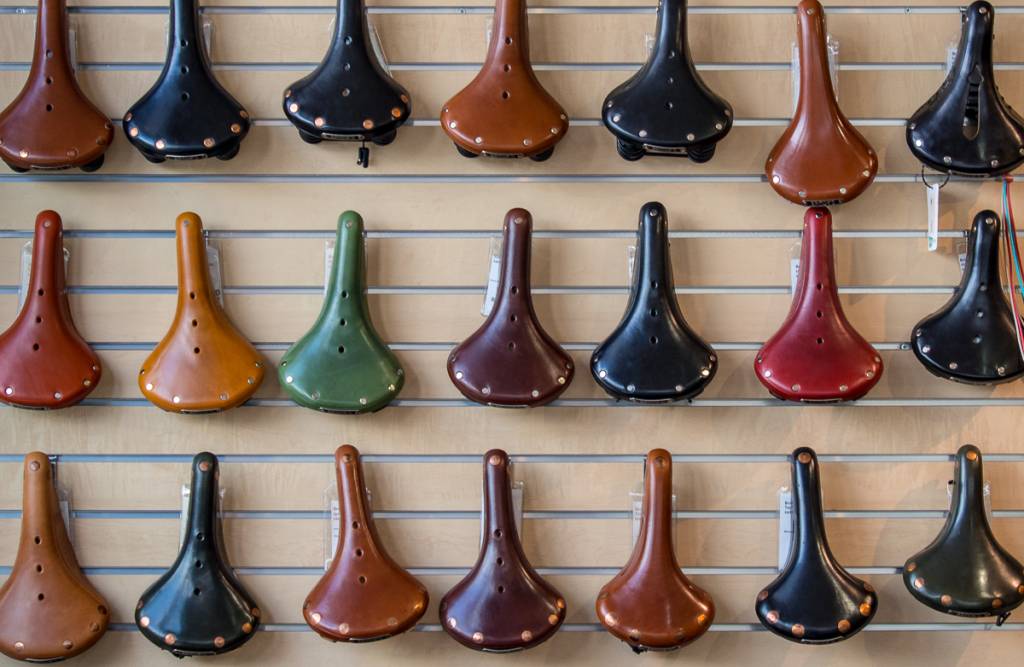Lots of people have either limited, often very old memories or third-hand opinions about Brooks saddles, usually along the lines of how (allegedly) hard they are to break in. I always ask "which model do you mean, on which bike?" The Wall shows at a glance that Brooks saddles aren't one thing, not any more than leather shoes are one thing. Lots of people know that leather shoes are often stiffer than ideal at first, but agree that after a tolerably short period are simply the best. It's no different with saddles.
At the upper left are a few narrower, sporty models, such as the Swift and B232 "Professional", some of which have extra-thick leather to endure long wet training winters. These are mainly to blame for the lore about long or endless break-in periods, especially among those who would be much happier with models suiting more upright riding styles. We sell almost none of these in town, since we are not about sport, but a few move via mail order. For many decades now, people interested in sport go for plastic over leather anyway, because it's lighter for a given resilience.
At the lower right is basically a tractor saddle, the B190. There are probably some whole bikes that weigh less than this saddle, with its elaborate steel spring double suspension. If you are a very large person sitting bolt upright many hours at a time, this is for you. In 10 years we've sold twice as many B190s as Swifts.
Through the middle are the most popular models, those based on the B17 and B67 tops, in their various sprung and unsprung flavors, long and short-nosed, in various colors. Broadly, if on your bike, your hands are within an inch or two of your saddle height, then you're likely to prefer a saddle in the B17 family. If your hands are higher, then a B67 type. The more upright you sit, the broader your ideal saddle is likely to be. Past a certain width, with even more uprightness, springs add comfort, cushioning a vertical spine from road shock not absorbed by tires. Some people even with less upright postures appreciate that sprung models allow the saddle to rock laterally, tracking pelvis movement.
Most Brooks saddles come in a standard and short (S) version. The shorts are marketed as for women. I don't think there's any anatomical basis for this. It's just that the shorter-nosed versions are less likely to interfere with a skirt. Since they are shorter, they are also a bit stiffer. In consideration of the statistically lower body mass of women versus men, this can mean a longer break in period for women selecting the short versions. We often recommend trying the full-length version first, regardless of sex, unless skirt-friendliness is a major deciding factor.
We offer a year-long satisfaction guarantee on Brooks saddles: beyond our normal 30-day return policy. We issue store credit for the full purchase price. In the few years we've offered this, only 4 people have taken us up on it: one exchanged for another model. Another got it as a gift, and never even tried it. The others, well... anatomical outliers? We really like it when people try our products before buying, to avoid unnecessary returns and general dissatisfaction. If you're interested in a Brooks, please ride on over to let us fit one for you: adjustments matter! If the initial stiffness puts you off, we usually have a few lightly ridden ones on hand to help assure you things get softer soon. It's rare that it takes more than 100 miles for any of the B17 types we sell to become compliant, while most B67 types are good within a few days.







